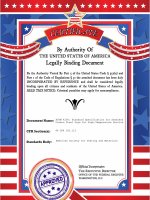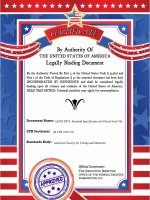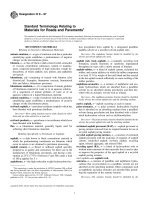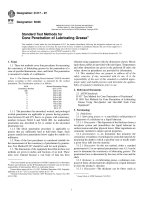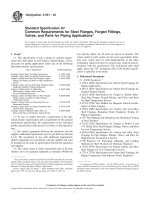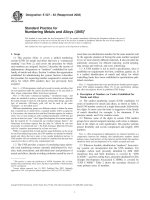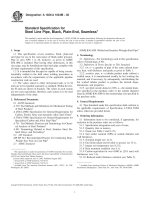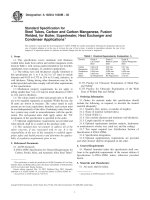Tiêu chuẩn ASTM A 1005 : Standard Specification for Steel Line Pipe, Black, Plain End, Longitudinal and Helical Seam, Double SubmergedArc Welded
Bạn đang xem bản rút gọn của tài liệu. Xem và tải ngay bản đầy đủ của tài liệu tại đây (51.35 KB, 6 trang )
Designation: A 1005/A 1005M – 00e1
Standard Specification for
Steel Line Pipe, Black, Plain End, Longitudinal and Helical
Seam, Double Submerged-Arc Welded1
This standard is issued under the fixed designation A 1005/A 1005M; the number immediately following the designation indicates the
year of original adoption or, in the case of revision, the year of last revision. A number in parentheses indicates the year of last
reapproval. A superscript epsilon (e) indicates an editorial change since the last revision or reapproval.
e1 NOTE—Editorial corrections were applied throughout August 2000.
lated Alloys, and Ferroalloys2
2.2 ASME Standards:
ASME B36.10 Welded and Seamless Wrought Steel Pipe4
ASME Boiler and Pressure Vessel Code, Section VIII,
Unfired Pressure Vessels4
ASME Boiler and Pressure Vessel Code, Section IX, Welding and Brazing Qualifications4
2.3 API Publications:
API RP 5L3 Recommended Practice for Conducting DropWeight Tear Tests on Line Pipe5
API Standard 1104 Welding of Pipelines and Related Facilities5
1. Scope
1.1 This specification covers double submerged-arc welded,
black, plain end steel pipe for use in the conveyance of fluids
under pressure. Pipe in sizes NPS 16 and larger, as given in
ASME B36.10, are included; pipe having other dimensions, in
this size range, are permitted, provided such pipe complies
with all other requirements of this specification.
1.2 It is intended that pipe be capable of being welded in the
field when welding procedures in accordance with the requirements of the applicable pipeline construction code are used.
1.3 The values stated in either inch-pound units or in SI
units are to be regarded separately as standard. The values in
each system are not exact equivalents, therefore, each system is
to be used independently of the other, without combining
values in any way.
1.4 The following precautionary statement pertains to the
test method portion, Section 14 of this specification: This
standard does not purport to address all of the safety concerns,
if any, associated with its use. It is the responsibility of the user
of this standard to establish appropriate safety and health
practices and determine the applicability of regulatory limitations prior to use.
3. Terminology
3.1 Definitions of Terms Specific to This Standard:
3.1.1 double submerged-arc welding, n—a welding process
that produces coalescence of metals by heating them with an
arc of arcs between a bare metal electrode or electrodes and the
work pieces, using at least one pass from the inside and at least
one pass from the outside to make the longitudinal, helical, and
skelp end weld seams, whichever are applicable, the arc or arcs
and the molten metal are shielded by a blanket of granular,
fusible material on the work pieces.
3.1.2 jointer, n—not more than three lengths of pipe circumferentially welded together to produce a single length that
complies with the length provisions of this specification.
3.1.3 skelp, n—the flat rolled product intended to be formed
into pipe.
3.1.4 skelp end, n—the weld joining the ends of two lengths
of skelp.
3.1.5 specified outside diameter, n—the outside diameter
shown in B36.10M or that stated on the order.
3.1.6 test lot, n—a quantity of pipe of the same ordered
diameter, heat, and wall thickness.
3.2 Definitions: For definitions of other terms used in this
specification, refer to Terminology A 941.
2. Referenced Documents
2.1 ASTM Standards:
A 370 Test Methods and Definitions for Mechanical Testing
of Steel Products2
A 450/A 450M Specification for General Requirements for
Carbon, Ferritic Alloy, and Austenitic Alloy Steel Tubes2
A 530/A 530M Specification for General Requirements for
Specialized Carbon and Alloy Steel Pipe2
A 751 Test Methods, Practices, and Terminology for
Chemical Analysis of Steel Products3
A 941 Terminology Relating to Steel, Stainless Steel, Re-
1
This specification is under the jurisdiction of ASTM Committee A01 on Steel,
Stainless Steel and Related Alloys and is the direct responsibility of Subcommittee
A01.09 on Carbon Steel Tubular Products.
Current edition approved Jan. 10, 2000. Published May 2000.
2
Annual Book of ASTM Standards, Vol 01.01.
3
Annual Book of ASTM Standards, Vol 01.02.
4
Available from American Society of Mechanical Engineers, Three Park
Avenue, New York, NY 10016-5990.
5
Available from American Petroleum Institute, 1220 L Street, N.W., Washington, DC 20005-4070.
Copyright © ASTM International, 100 Barr Harbor Drive, PO Box C700, West Conshohocken, PA 19428-2959, United States.
1
A 1005/A 1005M – 00e1
7.2 The steel shall contain no more than 0.0007 % boron, by
heat analysis.
7.3 The carbon equivalent (CE) shall not exceed 0.40 %,
calculated from any reported product analysis using the following equation:
4. General Requirements
4.1 Pipe furnished under this specification shall conform to
the applicable requirements of Specification A 530/A 530M
unless otherwise provided herein.
5. Ordering Information
5.1 Information items to be considered, if appropriate, for
inclusion in the purchase order are as follows:
5.1.1 Specification designation and year of issue,
5.1.2 Quantity (feet or metres),
5.1.3 Grade (see Table 1 or 8.5),
5.1.4 Size, either nominal (NPS) or outside diameter and
wall thickness,
5.1.5 Nominal length (see 16.3),
5.1.6 Diameter tolerances for pipe larger than NPS 43 (see
16.4),
5.1.7 End finish (plain and beveled or special, see 17.1),
5.1.8 Jointers (See Section 19),
5.1.9 Special requirements,
5.1.10 Supplementary requirements,
5.1.11 Charpy V-notch impact energy (see 9.4), and
5.1.12 Bar coding (see 21.2).
CE 5 C 1 F
Carbon Content, %
<0.06
0.06
0.07
0.08
0.09
0.10
35
50
60
70
80
A
35000
50000
60000
70000
80000
[240]
[345]
[415]
[485]
[550]
65
77
80
87
97
000
000
000
000
000
[450]
[530]
[550]
[600]
[670]
000
000
000
000
000
F
0.53
0.54
0.56
0.58
0.62
0.66
Carbon Content, %
0.11
0.12
0.13
0.14
0.15
0.16
F
0.70
0.75
0.80
0.85
0.88
0.92
8.1 Except as allowed by 8.5 the material shall conform to
the requirements for tensile properties given in Table 1.
8.2 The yield strength corresponding to a total extension
under load of 0.5 % of the gage length shall be determined.
8.3 A test specimen taken across the longitudinal, helical, or
skelp end weld, whichever are applicable, shall show a tensile
strength not less than the minimum tensile strength specified
for the grade of pipe required. Test specimens shall contain the
weld reinforcement and shall exhibit at least 10 % elongation
in 2 in. [50 mm].
8.4 Transverse body tension test specimens shall be taken
opposite the weld, for longitudinally welded pipe. For helical
welded pipe the transverse body tension test shall be taken 90°
to the axis of the pipe and approximately halfway between
adjacent weld convolutions.
8.5 Grades intermediate to those given in Table 1 shall be
furnished if so specified in the purchase order. For such grades,
the permissible yield strength range shall be as given in Table
1 for the next higher grade, and the required minimum tensile
strength shall exceed the required minimum yield strength by
the same amount as given in Table 1 for the next higher grade.
8.6 The ratio of yield strength to tensile strength for all pipe
body tests shall not exceed 0.90 for Grades 70 and lower. For
grades higher than Grade 70, the ratio shall not exceed 0.93.
Tensile Strength, min
psi
MPa
60
70
75
80
90
(1)
8. Tensile Property Requirements
TABLE 1 Tensile RequirementsA
Yield Strength, max
psi
MPa
G
7.4 A heat analysis shall be made for each heat of steel
furnished under this specification.
7.5 Product analyses shall be made on at least two samples
from each heat of steel. Product analysis for boron is not
required.
7.6 Except as provided in 7.5, all analyses shall be in
accordance with Test Methods, Practices, and Terminology
A 751, and shall include all elements required in the carbon
equivalent equation of 7.3, in addition to titanium, phosphorus,
sulfur, and boron.
7.7 If one or both of the product analyses representing a heat
fails to conform to the specified requirements, the heat shall be
rejected, or analyses shall be made on double the original
number of test samples that failed, each of which shall conform
to the requirements.
7. Chemical Composition
7.1 The steel for any grade shall contain no more than
0.16 % carbon, by heat and product analyses.
Yield Strength, min
psi
MPa
Mn Si Cu Ni Cr 1 Mo 1 V 1 Cb
6 1 24 1 15 1 20 1
5
where: F is a compliance factor that is dependent on the
carbon content as follows:
6. Materials and Manufacture
6.1 Skelp widths for helical seam pipe shall be neither less
than 0.8 nor more than 3.0 times the pipe’s specified outside
diameter.
6.2 The longitudinal, helical, and skelp end welds, whichever are applicable, shall be made using welding procedures
qualified in accordance with the requirements of the ASME
Boiler and Pressure Vessel Code, Section IX.
6.3 Skelp end welds shall not be permitted in finished pipe,
except for helical seam pipe having its skelp end welds
manufactured by double submerged-arc welding. For such
pipe, skelp ends shall have been properly prepared for welding.
Junctions of skelp end welds and helical seam welds shall not
be located within 12 in. [300 mm] of pipe ends or jointer welds.
Junctions of skelp end welds and jointer welds shall be
separated by a minimum circumferential distance of 6 in. [150
mm] from junctions of the helical seam weld and the jointer
weld. Skelp end welds shall be permitted at finished pipe ends,
provided that there is a minimum circumferential separation of
6 in. [150 mm] between the skelp end weld and the helical
seam weld at the applicable pipe ends.
Grade
F
[415]
[485]
[515]
[550]
[620]
Yield strength requirements do not apply to transverse weld tests.
2
A 1005/A 1005M – 00e1
10. Guided Bend Test
10.1 Root and face guided bend tests shall be conducted in
accordance with Test Methods A 370. The specimens shall not
fracture completely and shall not reveal any cracks or ruptures
in the parent metal, heat affected zone, or fusion line longer
than 1⁄8 in. [3 mm] and deeper than 12 1⁄2 % of the specified
wall thickness, except that cracks that occur at the edges of the
specimen and are less than 1⁄4 in. [6 mm] long shall not be
cause for rejection, regardless of depth.
8.7 For pipe body tests, the minimum elongation in 2 in. [50
mm] for all grades shall be that determined by the following
equation:
A0.2
e 5 C 0.9
U
(2)
where:
e = minimum elongation in 2 in. [50 mm] in percent,
rounded to the nearest percent,
C = 625 000 [1940],
A = the lesser of 0.75 in2 [485 mm2] and the cross-sectional
area of the tension test specimen, calculated using the
specified width of the test specimen and the specified
wall thickness of the pipe, with the calculated value
rounded to the nearest 0.01 in2 [1 mm2], and
U = specified minimum tensile strength, psi [MPa].
11. Hydrostatic Test
11.1 Each length of pipe shall be subjected to the hydrostatic test without leakage through the wall, except that jointers
that are comprised of segments that have passed hydrostatic
testing need not be hydrostatically tested.
11.2 Each length of pipe shall be tested, by the manufacturer, to a minimum hydrostatic pressure calculated from the
following relationship:
Inch-Pound Units:
9. Charpy V-Notch Test
9.1 Except as allowed by 9.2, all pipe shall be Charpy
V-notch tested in accordance with Test Methods and Definitions A 370. All pipe body tests shall be transverse to the pipe
axis, taken approximately 90° from the weld. All weld tests
shall be transverse to the weld axis.
9.2 The basic specimen is full size Charpy V-notch. For pipe
with a specified wall thickness of 0.236 in [5.9 mm] or less,
there is no requirement for Charpy V-notch testing. Where
combinations of diameter and wall do not permit the smallest
specimen size, there is no requirement for proven fracture
toughness. In all cases, the largest possible specimen size shall
be used, except where such a specimen size will result in
energy values greater than 80 % of the testing machine
capacity:
Specified Wall Thickness, in. [mm]
$ 0.434 [11.0]
0.304–0.433 [7.7–10.9]
0.237–0.303 [6.0–7.6]
(4)
St
P 5 2000 D3 C
(5)
SI Units:
where:
P = minimum hydrostatic test pressure, psi [kPa],
S = specified minimum yield strength, psi [MPa],
t = specified wall thickness, in. [mm],
D = specified outside diameter, in., [mm],
C = 0.85 for pipe NPS 16 through NPS 18, and
= 0.90 for pipe larger than NPS 18.
11.3 When computed test pressures are not an exact multiple of 10 psi [100 kPa], they shall be rounded to the nearest
10 psi [100 kPa].
11.4 The minimum hydrostatic test pressure required to
satisfy these requirements need not exceed 3000 psi [20 700
kPa]. This does not prohibit testing at a higher pressure at the
manufacturer’s option. The hydrostatic test pressure shall be
maintained for not less than 5 s for all sizes.
Specimen Size To Be Used
Full
2⁄3
1⁄2
9.3 When specimens smaller than full size are used, the
requirements of 9.4 shall be adjusted by one of the following
relationships:
For 2 / 3 size: N 5 R 3 0.67
St
P52D3C
(3)
12. Nondestructive Examination
12.1 General—The full length of each longitiudinal, helical
and skelp end weld shall be subjected to ultrasonic inspection
in accordance with 12.3, in combination with radiography in
accordance with ASME Boiler and Pressure Vessel Code,
Section VIII, Paragraph UW51. Radiographic inspection shall
include at least 8 in. [200 mm] of weld from each pipe end.
12.2 All required nondestructive examination (NDE) shall
be performed after hydrostatic test, except for the nondestructive examination (NDE) of jointer welds and the radiographic
inspection of pipe ends.
12.3 Ultrasonic Inspection—Any equipment utilizing ultrasonic principles and capable of continuous and uninterrupted
inspection of the weld seam shall be used. The equipment shall
be checked with an applicable reference standard, as described
in 12.3.1 at least once every working turn or not more than 8
hours to demonstrate the effectiveness of the inspection procedures. The equipment shall be adjusted to produce well
For 1 / 2 size: N 5 R 3 0.50
where:
N = adjusted value, rounded to the nearest whole number,
and
R = applicable value from 9.4 and 9.6.
9.4 The Charpy V-notch energy impact energy for the pipe
body shall be not less than 30 ft-lbf [40 J] minimum average,
or any higher value specified in the purchase order.
9.5 All Charpy V-notch testing shall be performed at 32°F
[0°C], or lower as agreed upon between purchaser and manufacturer or at the manufacturer’s option.
9.6 A test of weld and HAZ Charpy V-notch impact energy
properties shall be made on each type (longitudinal, helical, or
skelp end) of weld. The Charpy V-notch impact energy shall be
not less than 30 ft-lbf [40 J].
9.7 Each pipe body Charpy V-notch specimen shall exhibit
at least 75 % shear area.
3
A 1005/A 1005M – 00e1
defined indications when the reference standard is scanned by
the inspection unit in a manner simulating inspection of the
product.
12.3.1 Reference Standards—Reference standards shall
have the same diameter and thickness as the product inspected,
and may be of any convenient length as determined by the pipe
manufacturer. Reference standards shall be either full sections
or coupons taken from the pipe. The reference standard shall
contain machined notches or a drilled hole, with the following
dimensions:
13.4 Charpy V-notch test frequency shall be one set of
specimens for each 100 joint test lot, except for skelp end
welds, which shall be tested one for each 100 pipe containing
such end welds.
Parallel Sided Notch (A)
Depth − 5 % t 6 15 %
with min of
0.012 6 0.002 in.
[0.3 6 0.05 mm]
Width – 0.04 in. [1 mm] max
Length – 2 in. [50 mm] min at full
depth
15. Dimensions and Weights [Masses] Per Unit Length
15.1 The dimensions and weights [masses] per unit length
of some of the pipe sizes included in this specification are
shown in ASME B36.10M. The weight [mass] per unit length
of pipe having intermediate diameter and/or wall thickness is
determined using the applicable equation in 16.1.
⁄
1 16
14. Test Methods
14.1 The test specimens and the tests required by this
specification shall conform to those described in Test Methods
and Definitions A 370.
Drilled Hole
in. [1.6 mm] diameter
NOTE 1—The reference discontinuities defined herein are convenient
standards for calibration of nondestructive testing equipment. The dimensions of these discontinuities should not be construed as the minimum size
imperfection detectable by such equipment.
16. Permissible Variations in Weight [Mass] and
Dimensions
16.1 Weight [Mass]—The weight [mass] of a single length
of pipe shall not vary more than +10 % , −3.5 % from its
theoretical weight [mass]. Pipe weights [masses] per unit
length not listed in ASME B36.10M shall be determined using
the following equation:
inch-pound units:
12.3.2 Surface Condition, Operator Qualifications—Extent
of Examination, and Standardization Procedure– Surface condition, extent of examination, operator qualifications, and
standardization procedure shall be in accordance with the
requirements of Specification A 450/A 450M.
12.3.3 Acceptance Limits—Table 2 gives the height of
acceptance limit signals in percent of the height of signals
produced by the reference discontinuities. Imperfections in the
weld seam that produce a signal greater than the acceptance
limit given in Table 2 shall be considered defects.
12.4 Disposition of NDE Defects—Pipe that has been rejected in accordance with the provisions of 12.1 or 12.3 shall
be given one of the following dispositions:
12.4.1 The pipe length shall be rejected.
12.4.2 The portion of the pipe containing the defect shall be
cut off.
12.4.3 The defect shall be removed by grinding, provided
that the remaining wall thickness is within specified limits.
12.4.4 The area of the pipe containing the defect shall be
repaired by welding.
W 5 t ~D2t! 3 10.69
(6)
W 5 t ~D2t! 3 0.024 66
(7)
SI units:
where:
W = weight [mass] per unit length, lb/ft [kg/m],
D = specified outside diameter, in. [mm], and
t = specified wall thickness, in. [mm].
The weight [mass] of any order item shall not be more than
1.75 % under its theoretical weight.
16.2 Wall Thickness—The minimum wall thickness at any
point shall not be more than 8 % under the specified wall
thickness.
16.3 Length—Unless otherwise agreed upon between the
purchaser and the manufacturer, pipe shall be furnished in the
nominal lengths and within the permissible variations given in
Table 3.
16.4 Diameter—For pipe sizes larger than NPS 48, the
diameter tolerances shall be subject to agreement between the
manufacturer and the purchaser. The diameter tolerance within
4 in. [100 mm] of each pipe end shall be −1⁄32 , + 3⁄32 in. [−1,
+3 mm].
13. Number of Tests
13.1 Tensile testing of the pipe body, longitudinal welds,
and helical welds shall be performed on a test lot basis with a
lot size of one sample for each lot of 100 joints of pipe or less.
13.2 Tensile testing of skelp end welds shall be performed at
a frequency of one test per lot of 100 lengths containing skelp
end welds.
13.3 The guided bend test specimens shall be taken from
each lot of 50 lengths or less of each combination of specified
outside diameter, specified wall thickness, and grade.
17. End Finish
17.1 Pipe furnished to this specification shall be plain-end
beveled with ends beveled to an angle of 30°, +5°, −0°,
measured from a line drawn perpendicular to the axis of the
pipe, and with a root face of 1⁄16 in. [1.6 mm] 6 1⁄32 in. [0.8
mm], or special plain end, as specified in the purchase order.
TABLE 2 Acceptance Limits
Top of Notch
A
Size of Hole
in.
1⁄16
mm
1.6
18. Workmanship, Finish and Appearance
18.1 The weld bead shall not extend above the prolongation
of the original surface of the pipe by more than 1⁄8 in. [3.2 mm]
Acceptance Limit
Signal, %
100
4
A 1005/A 1005M – 00e1
TABLE 3 Permissible Variations on Lengths
Nominal Length
Minimum Length
Minimum Avg Length
for Each Order Item
Maximum Length
ft
m
ft
m
ft
m
ft
m
20
40
50
60
80
[6]
[12]
[15]
[18]
[24]
9.0
14.0
17.5
21.0
28.0
[2.74]
[4.27]
[5.33]
[6.40]
[8.53]
17.5
35.0
43.8
52.5
70.0
[5.33]
[10.67]
[13.35]
[16.00]
[21.34]
22.5
45.0
55.0
65.0
85.0
[6.86]
[13.72]
[16.76]
[19.81]
[25.91]
and a prolongation of the original contour of the pipe. Cold
formed dents deeper than 1⁄8 in. [3.2 mm] shall be free of
sharp-bottom gouges. The gouges may be removed by grinding, provided that the remaining wall thickness is within
specified limits. The length of the dent in any direction shall
not exceed one half the pipe diameter.
for pipe specified wall thickness 0.500 in. [12.7 mm] and
smaller, or more than 3⁄16 in. [4.8 mm] for specified wall
thicknesses greater than 0.500 in. [12.7 mm]. The weld surface
shall not be below a prolongation of the original surface.
18.2 Surface imperfections that penetrate more than 8 % of
the nominal wall thickness or encroach on the minimum wall
thickness shall be considered defects. Pipe with surface defects
shall be given one of the following dispositions:
18.2.1 The defect shall be removed by grinding, provided
that the remaining wall thickness is within specified limits.
18.2.2 When imperfections or defects are removed by
grinding, a smooth curved surface shall be maintained, and the
wall thickness shall not be decreased below that permitted by
this specification. The outside diameter at the point of grinding
may be reduced by the amount so removed.
18.2.3 The section of the pipe containing the defect shall be
cut off within the requirements for length.
18.2.4 The length shall be rejected.
18.3 Wall thickness measurements shall be made with a
mechanical caliper or with a properly calibrated nondestructive
testing device of appropriate accuracy. In case of a dispute, the
measurement determined by the use of a mechanical caliper
shall govern.
18.4 Pipe body repairs by welding are not permitted.
18.5 Repairs of the weld are permissible in accordance with
Specification A 530/A 530M except that the repair depth shall
not exceed 70 % of the specified wall thickness of the pipe and
back-to-back repairs are not permitted. No repair of repair weld
is permitted.
18.6 Pipe shall be randomly checked for straightness. Deviation from a straight line shall not exceed 0.2 % of the length.
18.7 The pipe shall contain no dents greater than 1⁄4 in. [6.4
mm], measured as the gap between the lowest point of the dent
19. Jointers
19.1 Jointers may be furnished, subject to agreement between manufacturer and purchaser as to minimum length of
each piece and total number of jointers. Circumferential jointer
welds shall be made using a procedure qualified in accordance
with the requirements of API 1104 or ASME Boiler and
Pressure Vessel Code, Section IX and inspected by radiographic or ultrasonic procedures or a combination of both.
20. Certification
20.1 A certified test report shall be furnished.
21. Product Marking
21.1 Each length of pipe shall be legibly marked by stenciling to show: specification number, the name or brand of the
manufacturer, the specified outside diameter, the specified wall
thickness, the grade, the heat number, and the length. The
length shall be marked in feet and tenths of a foot, or metres to
two decimal places, as applicable.
21.2 In addition to the requirements of 21.1, bar coding is
acceptable as a supplementary identification method. The
purchaser may specify in the order a specific bar coding system
to be used.
22. Keywords
22.1 black steel pipe; double submerged-arc welded; line
pipe
5
A 1005/A 1005M – 00e1
SUPPLEMENTARY REQUIREMENTS
The following supplementary requirement shall apply only when specified in the purchase order.
S1. Drop-Weight Tear Testing
S1.1 The drop-weight tear test shall be conducted in accordance with API RP 5L3.
S1.2 The temperature selected for conducting the dropweight tear test, the test frequency, and the criteria for
acceptance shall be as specified in the purchase order.
ASTM International takes no position respecting the validity of any patent rights asserted in connection with any item mentioned
in this standard. Users of this standard are expressly advised that determination of the validity of any such patent rights, and the risk
of infringement of such rights, are entirely their own responsibility.
This standard is subject to revision at any time by the responsible technical committee and must be reviewed every five years and
if not revised, either reapproved or withdrawn. Your comments are invited either for revision of this standard or for additional standards
and should be addressed to ASTM International Headquarters. Your comments will receive careful consideration at a meeting of the
responsible technical committee, which you may attend. If you feel that your comments have not received a fair hearing you should
make your views known to the ASTM Committee on Standards, at the address shown below.
This standard is copyrighted by ASTM International, 100 Barr Harbor Drive, PO Box C700, West Conshohocken, PA 19428-2959,
United States. Individual reprints (single or multiple copies) of this standard may be obtained by contacting ASTM at the above
address or at 610-832-9585 (phone), 610-832-9555 (fax), or (e-mail); or through the ASTM website
(www.astm.org).
6
